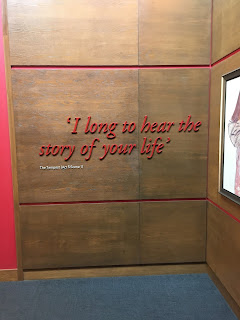Coming full circle, we also visited Shakespeare's funerary monument located in the Holy Trinity Church. The monument was particularly interesting because it was created with the input and approval of his wife, and therefore is considered to be an accurate depiction of his likeness.
In the evening we went to the Royal Shakespeare Company's production of Measure for Measure. Set in 1900's Vienna, the Duke of Vienna departs, leaving his trusted and pious friend Angelo in charge. Novice Isabella approaches Angelo to spare her brother Claudio from execution, but Angelo will not unless she sleeps with him. The Duke disguised as a friar and Isabella hatch a plan to avoid Claudio's execution and preserve her virginity. In the end no one dies, but the Duke's proposal seems to negate how far we've come. Although filled with wonderful, compelling performances (especially Lucy Phelps as Isabella and Sandy Gierson as Angelo), the play hasn't aged well in the #metoo era.





















































